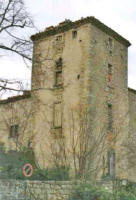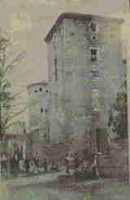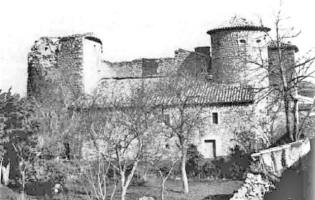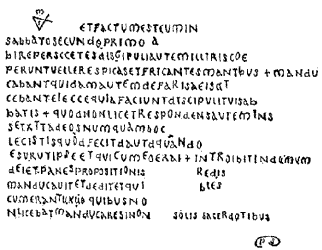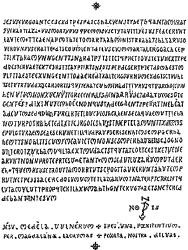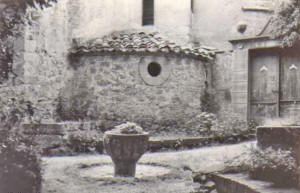|
Village
Rennes le Château was previously called Rennes and Rennes les Bains
was Bains de Rennes. In 1874, there were 492 inhabitants in Rennes
les Bains, and 351 in Rennes le Château , and in 1885, there were 447
in Rennes le Bains and 298 in Rennes le Château.
In 1879, the mayor was Mr Tuysseyre
The castle that had belonged to Elizabeth de Rennes was sold by
auction to Julie Avignon on September 2nd 1816. This lady was married
to Michel Captier who became the mayor of Rennes le Château in 1816.
The castle was sold to the brothers Dalbiès from Couiza.
Position : 42° 55’ 41 N - 2° 15’ 45 E. Altitude 546m (?)
A bit of history
-
-50000 : traces of graves.
-
-300 : Slight Celt occupation. Civilization of the Redones
-
-121 : Roman occupation.
-
Early 5th century, Visigoths.
Rhédae was the capital of Septimanie, the county town of the diocese
of Rhédénium.
-
725 : Saracen invasion.
-
771 : The church of Rennes was built.
-
1062 : Frank invasion. Rhédae as a royal city was at its peak :30000
inhabitants.
-
1067 : Rhédésium was sold to the House of Barcelona.
-
1130 : The earldom of Rhedae was joined to the earldom of
Carcassonne, which belonged to the Trencavel family.
-
1170 : Alphonse 2 of Aragon attacked Rhédae. The Trencavel family
only retained the town.
-
13th century : War between France and Occitanie.
Simon of Montfort got Rhédae, and gave it to Pierre de Voisins.
-
1215-1360 : Rhédae became once again an important city, thanks to
Pierre de Voisins’s efforts.
-
1360 : Rhédae was attacked by " les routiers ", thiefs and brigands.
-
1361 : Plague epidemic.
-
1362 : The count of Trastamarre attacked Rhédae.
The town was destroyed … The earldom was then called "le Razès" and
Rhédae, Rennes le Château.
-
1400 : The de Voisins’s last daughter married a lord of Marquefave.
-
1422 : Blanche de Marquefave married Pierre-Raymond of Hautpoul, in
her dowry was the barony of Rennes.
-
1680 : Henri, baron of Hautpoul, took back the title of lord of
Blanchefort.
-
1762 : The last of the Blancheforts died, his wife, Marie is left
alone ( she was born as Negri Dables)
-
1781 : Marie d’Hautpoul, Marchionness of Blanchefort died. She
was 67
|
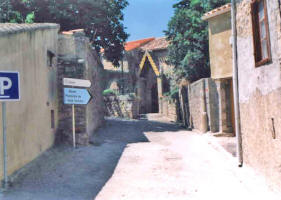
Church
street |
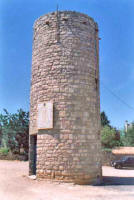
Water Tower
|
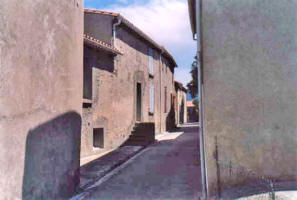
A street
|
Underground Passage
Know for many years amongst
the villagers, this underground passage was reopened in July 99 and
could be used again. It is situated under the water tank near the
castle.
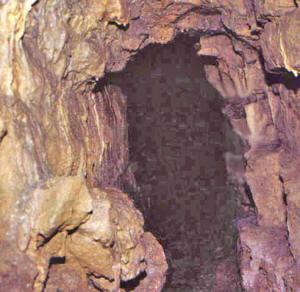
Go Back
Surroundings
|
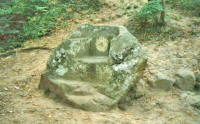
Devil’s armchair
|
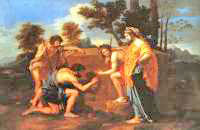
Pontils Tomb
-
click image
for report |
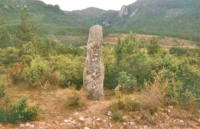
The Raised
Stone |
|
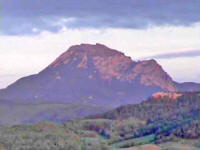
Pech Bugarach
|
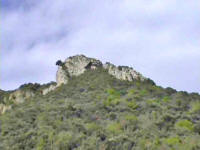
Blanchefort
|
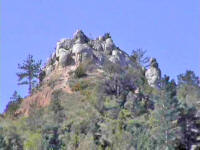
La Pique de Lavaldieu
|
|
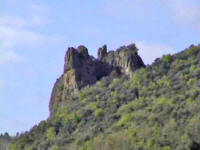
Roco Negro
|
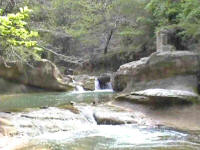
Fontaine des
Amours
|
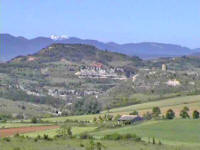
Casteillas
|
|
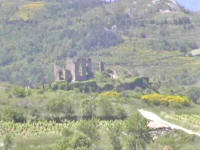
Coustaussa
|
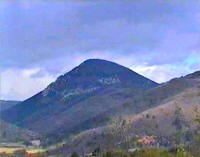
Pech Cardou
|
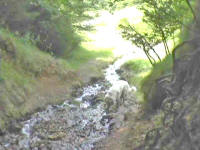
Salz Fountain
|
Report on Pontils Tomb
Go Back
Scrolls
Warning
Everything that follows about Sauniére’s famous scrolls is only
hypothesis and interpretations made from tracing papers which were
supposed to be copies of the REAL documents. There’s no evidence to
prove those scrolls did exist. On the other hand the testimonies of
people who had lived next to Sauniere all agree : they never talked
about scrolls. They told their story in the 60’s and it was
developed by the medias. We can quote Madame Leontine Marre, a
contemporary of Sauniere:
"They (the journalists) never write my words in their papers, they
always write about scrolls found in the altar’s pillar, and I never
talked about such a thing!"
The Coded Scrolls
This is an exclusive study Mr Gerard Papadimopoulos sent us and for
which we thank him:
The translation of what’s left of the message (REDIS BLES SOLIS
SACERDOTIBUS) is: The treasure of Rennes is for the initiated.
Moreover we can notice if we draw a line across the page, starting on
the cross on the right of the 4th ligne just before the word MANDU
towards the 2nd cross on the 10th line and ending on the next to
last N , we find the word SION. So it can be thought this message has
a connection with the Priory of Sion. The signature at the bottom of
the message is obviously the Priory’s.
The signature on the 2nd scroll is strange. At first sight it
doesn’t look like anything but if you reverse it, you’ll find once
again SION.
The letters A(reversed) and N have not revealed their meaning yet(a
direction ?) but it seems they’re linked by a imperfect arrow.
There are also very little signs . If we take those signs as letters
and we follow the way they’re placed in the text, we get : REXMUNDI: REX MUNDI: King of the World.
Is it a new key to understand a new message ?
In the middle of the text , there is a capital A but all the other a
are small. After this A, there’s an (omega). So we have alpha and omega
:the beginning and the end. Between those 2 signs, out of line letters
write :ARETH.
If we take the 7 other out of line letters up, we have: ADGENES , so
it gives us : AD GENESARETH: towards Genesareth.
The Genesareth lake or lake Tiberias (sea of Galilee) is very
important in the New Testament.
If we take the other out of line letters at the bottom, we obtain
PANIS SAL :bread and salt.
So we have a new key :Towards Genesareth, bread and salt.
Saunière had given a tracing of the scrolls to the mayor of
Rennes. But in the 1910’s, the town hall was destroyed by fire , and
the tracing burnt with the other papers…. Some think another tracing
was left in Paris when he brought them to translate them. Philippe de
Chérisey gave it to Gérard de Sède in February 1964.
The first scroll was the smaller :
And so, one sabbat when he was walking across the fields, his
disciples lifted corn ears to eat them, crushing them in their
hands. Some Pharisee said :
"Why do you do forbidden things on a sabbat day?"
And Jesus answered:
"Have you not read about what
did David when he and his companions were hungry ?He entered the
House of God, took the priests’ bread and shared it with his
friends. And this bread was to be eaten only by priests. "
And he was
saying:
"the Son of Man is master of sabbat "
TN :Please, remember I have no English bible so these are not the
rights words. They’re a translation of the French one
If one put all the letters which are out of line, one’ll find the
sentence :
A Dagobert 2, roi et à Sion est ce trésor et il est la mort. (To king
Dagobert 2 and Sion this treasure belongs and it is death)
Or it can also be :
A Dagobert roi et à Sion est ce tresor, et il est là, mort. (To king
Dagobert 2 and Sion this treasure belongs and it lies there/here, dead)
Using the same technique, in the second scroll we find:
BERGERE PAS DETENTATION QUE POUSSIN TENIERS GARDENT LA CLEF PAX681
PAR LA CROIS ET CE CHEVAL DE DIEU J4ACHEVE CE DAEMON DE GARDIEN A
MIDI POMMES BLEUES.
click image
to enlarge
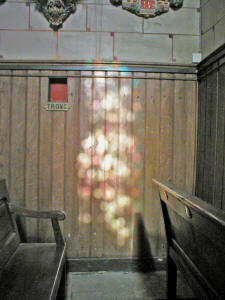
A Midi Pommes Bleues
(Blue Apples
at Midday)
Photo taken at 12:45pm in the church at Rennes le Chateau
on 17 January
2005
(SHEPHERDESS NO TEMPTATION MAY POUSSIN AND TENIERS GUARD THE KEY
PAX681 BY THE CROSS AND THIS GOD’S HORSE I FINISH THIS DEMON
GUARDIAN OFF AT MIDDAY
BLUE APPLES. )
Isn’t this amazing ? ?
The Family Tree
9 Merovingian princes would have lived in the castle of Rennes :
- Sigebert 4 know as " le Plantard " (the fiery son) (715-771)
- Sigebert 5(695-768)
- Bera 3 known as " Trounko " (715-771)
- Guillemon known as " Braou "( ? ? ?-773)
- Bera 4 known as " le Bolo "(755-836)-He was the founder of Alet
Abbey.
- Bera 5 (794-860)
- Hilderic 1 ( ? ? ?-867)
- Sigebert 6 known as " Ursus " ( ? ? ?-884)
It would have been kept by Father Hoffet and it would bear Blanche
de Castille’s royal seal . When he died, all his books and papers were
bougth by the International League of Antiquarian Booksellers ". On
July 2nd 1966 , the League wrote a letter to Mr Fatin , owner of the
castle of Rennes and archeologist, about his castle and a copy of the
scroll :
" Historically, [ this castle is] the most important in
France, because it was the refuge of Prince Sigebert 4 in 681, he was
King Dagobert 2(St Dagobert). It was also the house of their
descendants , counts of Rhédae and dukes of Razès… "
" This scroll was hidden in one of the three wooden rolls in the
Visigothic pillar of Mary Magdalene’s church in Rennes le
Château. This scroll was left there in 1788-1789 by Father
Bigou. Before this , it had been bound to François-Pierre, baron of
Hautpoul of Rennes ‘s testament which had been recorded by Captier
, lawyer in Espéraza, on November 1rst 1644. "
The Scrolls
Go Back
Hypotheses
-
A treasure is hidden in 12
hiding places in Rennes les Bains and Rennes le Château
area.
This theory comes from the interpretation of Father Boudet’s
book
-
Scrolls about genealogy of
France kings and Merovigians. .
See "scrolls":
the family tree
-
A document raising doubts about
the Gospel.
Christ didn’t die on the cross but he moved to Rennes with
Mary Magdalene whom he married. He had a child with her and
died peacefully in Rennes.
-
The Cathars treasure
-
The Philosophers’stone
-
The treasure of the Knight
Templars
-
A UFO base ? ? ? ?
-
The treasure of the Visigoths
This treasure was brought back to their capital :Toulouse, after
Roma was sacked. Because of the Franks, Visigoths made Rhédae
their capital and brought their treasure with them( ?)Roma
treasure wasn’t found in Toulouse. The Frank Frédégiaire
checked it. As the Franks were invading the South, the
Visigothsmoved to Tolede(Spain). Tolede was invaded by the
Arabs and El Macin who counted the treasure didn’t find any
Roman treasure. Could it have been left in Rennes ?
-
The Ark of the Covenant
Pierre Silvain told us in his book that the Ark was hidden
near Arques by the templars.
-
Jesus Christ’s grave
Two Englishmen think Jesus was buried in Rennes under Cardou
Mount because according to them Cardou comes from Corpus
Christi. In occitan (langue d’oc language) Cardou means
chardons (thistle).
Pierre Silvain told us tah the tomb of Christ is hidden
under the white mine near the city of God (Aleth)
Go Back
The Trial
Sauniere and the Bishopric
On January 15th 1909, Saunière received a letter from the
vicar-general of Carcassonne ‘s bishopric. With it were the official
documents telling him he was appointed to Coustouges , where he was
to go on February 1st 1909. After having thought, and following the
neighbour priests ‘s advices, Saunière sent his resignation on
January 28th 1909. Monseigneur (his grace) de Beauséjour accepted it
on the condition that Saunière left Rennes le Château. The major
wrote to the bishop to tell him the people was against his
decision, and that the inhabitants would refuse the new priest, and
not attend to his ceremonies.
Rennes-le-Château, le 6 février 1909
Le Maire de Rennes-le-Château à Monsieur l’Evêque à Carcassonne.
Monsieur,
En réponse à votre lettre du 31 janvier dernier, j’ai l’honneur de
vous faire savoir que je regrette le maintien de la décision prise à
l’égard de M. l’abbé Saunière. En ne donnant pas à la démarche que
le Conseil municipal de Rennes-le-Château a faite auprès de vous,
les suites que nous vous demandions vous et votre Conseil avez été
mal inspirés. Nous n’obtenons pas satisfaction ; tant pis ! Tant pis
aussi que vous ayez retiré à M. Saunière ses pouvoirs. Quant à
l’attitude de la population vis à vis de M. le curé d’Espéraza et du
successeur de M. Saunière, elle sera tout à fait simple : l’Eglise
désertée et les cérémonies religieuses remplacées par les cérémonies
civiles. Vous voyez, Monsieur l’Evêque, que vous n’aurez pas à vous
armer contre nous des foudres de l’Eglise. Quant au presbytère, il
est loué pour une durée de cinq ans, à partir du 1er janvier 1907 à
l’abbé Saunière. Mais je dois vous faire connaître qu’après
l’expiration du bail et même actuellement, s’il devenait libre par
suite du départ du locataire actuel, le Conseil municipal se refuse
formellement à passer un nouveau bail avec le desservant que vous
nous enverrez.
Je vous prie, Monsieur l’Evêque, d’agréer l’assurance de ma
considération très distinguée.
Rennes-le-Château, le 6 février 1909
Le Maire
Saunière was summoned by the bishopric several times but he never
went there, saying his health was bad. At last, he met the bishop on
March 31st 1909.
On July 2nd 1909, father Marty, priest of Coustaussa was appointed to
Rennes le Château. He settled there on July 4th 1909.
Saunière began to feel afraid; with the help of Father Le Vieux and
a lawyer from Chalabre, he wrote rough copies of 2 agreements, dated
of 3 months ago. They were to account for the sale of all of
Saunière’s furniture and decorations to Marie Dénarnaud for 4 000
golden francs (140 000 current francs) ; and the sell of Marie’s
lands and houses to Saunière for 12 000F (420 000F). Those figures
do not look like those Saunière sent to the bishop…
Monseigneur Billard asked Saunière not to accept anymore money for
masses from people outside the diocese. The priest began to be
suspected of masses traffic…
Saunière promised but he received 2 letters from the vicar-general
on December 18th and 22th to tell him a superior from the hopital
Pierre Larousse in Paris had asked the bishopric if father Saunière
could be trusted, because he had asked her to pay for masses. The
priest denied , but later acknowledged he had done it honestly.
Evêché de Carcassonne, le 18 Décembre 1909
Monsieur l’abbé Saunière,
La supérieure de l’Hôpital St Joseph, rue Pierre-Larousse n. 7 à
Paris, a écrit à Monseigneur, pour lui demander, si elle pouvait
vous envoyer des honoraires de Messe, en toute sûreté de conscience.
Vous devinez la réponse qui lui a été faite :
"Gardez-vous bien de continuer à faire de pareils envois; parce que
nous n’avons aucune confiance de la manière dont ce Prêtre acquitte
les intentions de Messes, qu’il se procure partout où il peut. "
Monseigneur constate avec peine, que vous continuez à demander des
honoraires de Messes en dehors du Diocèse. Et cependant vous aviez
promis et protesté que désormais vous n’en demanderiez jamais plus
qu’à lui seul, personnellement.
Voilà comment vous tenez votre promesse.
Sa Grandeur se demande, si sa conscience ne lui fait pas un devoir
de prendre des mesures efficaces pour faire cesser, une manière
d’agir si déplorable.
Je vous offre mes sincères salutations.
H. Rodière
Evêché de Carcassonne
Carcassonne, le 22 Décembre 1909
Monsieur l’abbé Saunière,
Vous affirmez, que depuis la promesse que vous avez faite à Mgr vous
n’avez plus demandé des honoraires de Messes à la Supérieure de
l’Hôpital St Joseph, à Paris. Or voici ce qu’elle nous écrit, à la
date de 28 octobre dernier. . .
"Pendant qu’il était encore à Rennes-le-Château,
comme Curé, Mr l’abbé Saunière s’était adressé à moi, sans me
connaître, (il avait eu mon adresse par quelqu’un), pour me demander
si je pourrais lui procurer quelques honoraires de Messes. . . Il m’a
écrit dernièrement, qu’il était maintenant Prêtre en retraite,
restant dans son ancienne Paroisse, et qu’il pourrait toujours
acquitter les Messes, qu’on lui enverrait. Comme je n’ai pas
l’avantage de le connaître, je vous serai reconnaissante de me dire,
si on peut en conscience, lui envoyer des honoraires de Messes. "
Voilà, deux affirmations, évidemment contradictoires.
Monseigneur vous sera reconnaissant, si vous voulez bien lui dire,
qu’elle est celle, qui est conforme à la vérité.
Recevez Monsieur l’abbé Saunière, mes sincères salutations.
H. Rodiére
v. , g.
Evêché de Carcassonne
Carcassonne, le 12 mai 1910
Monsieur l’abbé,
Voici le texte de la réponse, que Mgr me charge de donner à Mme
Gabrielle Camus, faubourg des Vosges à Mirecourt, qui demande si on
peut vous envoyer des honoraires de Messes en toute confiance.
M. . .
"Gardez-vous bien d’envoyer des honoraires de Messes à Mr l’abbé
Saunière, ancien curé de Rennes-le-Château, et retiré dans cette
Paroisse, parce que Mgr l’Evêque n’a aucune confiance en la manière,
dont ce Prêtre acquitte ses obligations, sur ce point".
Sa Grandeur voit avec peine, que vous ne tenez pas la promesse
formelle, que vous lui avez faite, de ne vous adresser qu’à elle,
quand vous seriez dépourvu d’honoraires.
Recevez, Monsieur l’abbé Saunière, mes sincères salutations.
H. Rodière
The topic of masses is dealt with in the section " synthesis "
Saunière went too far…On May 27th 1910, Monseigneur de Beauséjour
began a trial to forbid Saunière to ask for mass fees outside the
diocese.
On July 7th 1910, Saunière was summoned before the court. He did
nothing until July 15th 1910 (one day before he must face the court); he sent a letter to say he wouldn’t come because of his inability
to defend himself, and the risks for his health. He added he didn’t
asked for mass fees outside the diocese.
Rennes-le-Château, le 15 juillet 1910
Monseigneur
Comme j’ai eu l’honneur de le dire à Votre Grandeur dernièrement,
ainsi qu’à Monsieur le Vicaire général, pour les motifs que je vous
ai exposés, je ne viendrai point demain samedi, 16 courant, devant
le tribunal de l’Official, non pas que je ne le veuille point, mais
parce que je ne le puis. Pour paraître devant mes juges avec quelque
chance de succès, comme m’y invite la citation du 7 juillet, il me
faudrait d’abord être autorisé à faire connaître les noms des
personnes qui m’ont donné les fonds nécessaires à mes divers travaux,
or cette autorisation je ne l’ai point.
Il me faudrait ensuite le courage et l’énergie nécessaire, la
présence d’esprit, le sang froid et surtout la facilité de
m’exprimer et je ne possède absolument rien de tout cela. - Je sais
bien ce que vous allez me dire :
pourquoi ne pas prendre un avocat pour me représenter ? Oui tout
cela est fort bien, mais qui choisir ne connaissant, parmi le clergé
aucun membre apte à ma défense ? Et puis cet avocat en supposant que
j’eusse réussi à en trouver un susceptible d’être agréé par le
tribunal, vous aurait-il appris autre chose que ce que vous savez
déjà ? Non Enfin, comme je vous l’ai encore dit, les fortes émotions,
avec mon naturel impressionnable, étant excessivement contraires et
nuisibles à mon état de santé, d’après les conseils et les ordres de
mon médecin, je dois à tout prix les éviter, si je ne veux pas
m’exposer aux pires catastrophes. Et maintenant quant à la question
des honoraires de messes, laissez moi vous redire, Monseigneur, que
depuis votre défense, , je n’en ai plus demandé, bien que certaines
pièces de mon dossier semblent prouver le contraire et que ma
conscience n’est pas aussi coupable que ce que vous paraissez croire.
Avant de clore ces quelques lignes que j’ai cru bon de vous adresser,
je demande à Dieu de pardonner à mes ennemis et à tous ceux qui ont
cherché à me nuire et à me faire du mal, et je le prie, en même
temps de m’accorder la force nécessaire pour faire sa sainte volonté
et accepter en esprit de pénitence, ma condamnation quelle qu’elle
soit.
Daignez agréer, etc . .
B. Saunière
PS La maison que j’ai construite avec toutes ses dépendances,
comme semble l’insinuer un passage de la citation, n’a pas été
édifiée pour m’enrichir et pour y couler mes jours dans le luxe et
la mollesse, ma pensée, Monseigneur, comme il y a quelques années
j’ai eu l’honneur de vous le communiquer, était de vous l’offrir
pour une maison de retraite en faveur des prêtres âgés et infirmes -
habitation confortable - chapelle, bibliothèque, promenade, jardin,
terrasses, bon air, splendide panorama, rien n’aurait manqué aux
pauvres vieux, pas même une place réservée dans le cimetière de la
paroisse.
Je persiste toujours dans mon idée première, bien que le ciel semble
aujourd’hui se mettre en travers de mes projets et ne pas vouloir
les agréer.
Saunière did not come on July 16th 1910. He received then a
peremptory convocation for July 23rd 1910, which he answered on July
20th , announcing that Father Molinier, the oldest inhabitant of
Azilles , and Mr Mis, a lawyer in Limoux, would defend him. He asked for
8 more days to prepare his trial. As he got no answer, he sent another
letter on July 22nd.
On July 25th 1910, he received a letter telling his previous letters
went to the Bishopric, and as the bishop was absent and could not
read them…. the court passed sentence :Saunière was taken away his
right to be priest in the Carcassone diocese for one month…
Jugement contre Bérenger Saunière défaillant.
Nous Official du Diocèse de Carcassonne, au nom de la Sainte Trinité
et n’ayant en vue que la gloire de Dieu et le bien de l’Eglise.
Attendu que M. l’abbé Bérenger Saunière cité péremptoirement à
comparaître à ce jour devant notre tribunal a fait défaut et a été
déclaré contumace;
Ouï l’acte d’accusation de M. le promoteur reprochant à M. l’abbé
Saunière le trafic des messes, la désobéissance à son évêque et des
dépenses exagérées et non justifiées auxquelles semblent avoir été
consacrés les honoraires des messes non acquittées.
Après avoir pris l’avis de messieurs les assesseurs, jugeant par
défaut,
Condamnons M, l’abbé Bérenger Saunière à une suspense a divinis pour
le diocèse de Carcassonne d’une durée d’un mois.
de la sentence qui va vous être faite je mets un délai de 15 jours
pour la rendre exécutoire.
Votre tout dévoué en N. S
G. Cantagril v. g
This sentence weighed the priest down. He wrote to the bishop to tell
him he had no way to be represented by his lawyers during the trial.
On July31st , the bishop decided another trial would take place on
August 23rd . As it was the dates of the judges’ holidays, it was
reported to October 15th.
This time, Saunière choses Father Huguet to be his lawyer (He was a
canon, priest of Espiens par Nérac in the subdivision of Lot et
Garonne, and a former teacher in the university of Paris). But he was
sentenced to a retreat of 10 months in a monastery, although the
court though mass traffic could not be really proved.
The bishop asked Saunière to account for his expenses. The priest
sent a report of the prices of his buildings :
- Buying of three pieces of land 1 550 F
- Restoration of the church 16 293 F
- Calvary 11 200 F
- Bethania mansion 90 000 F
- Magdala Tower 40 000 F
- Garden 19 050 F
- In door decorations 5 000 F
- Furnitures 10 000 F
Which makes a total of 193 093F (We’re using the gold value of the
franc)
Contrary to what has been said, This document isn’t the letter
Saunière sent to the bishop, but its rough copy.
|
Currency equivalence table |
Golden-francs |
Current francs |
| Buying of three
pieces of land |
1 550 F |
54 250 F |
| Restoration of
the church |
16 293 F |
570 255 F |
| Calvary |
11 200 F |
392 000 F |
| Bethania mansion |
90 000 F |
3 150 000
F |
| Magdala Tower |
40 000 F |
1 400 000
F |
| Garden |
19 050 F |
666 750 F |
| Indoor
décorations |
5 000 F |
175 000 F |
| Furnitures |
10 000 F |
350 000 F |
| |
--------------- |
---------------------- |
| |
193 093 F |
6 758 255
F |
|
Obviously, those figures are wrong, Saunière pretended he spent more
money than he really did. For instance, at that time, a castle and 380
hectares were 100 000 golden francs.
Saunière appealed a second and last time, but it only added 3 months
to the initial sentence , on December 5th 1911. He presented his case
before the Vatican court, and Father Huguet went to Rome (using
Saunière’s money). Monseigneur de Beauséjour was ruled out of
court, but as he had no intention to let himself be pushed
around, Saunière is finally forbidden to do his job, which was decided
on April 11th 1915. During the trial, he had had problems concerning
money, and had had to mortgage one of his buildings for 6000 golden
francs.
Go Back
Documents
Go Back
Researches and Studies
Go Back
|
